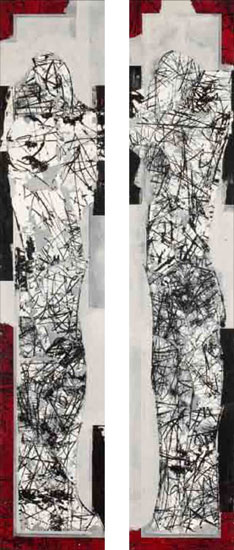VALENTIN OMAN
Aktuell
Vita
Arbeiten auf Leinwand
Arbeiten auf Papier
Öffentlicher Raum
Texte zu Oman
Filme zu Oman
Kontakt
Wayfarer through Time
Martin Traxl
If you come to meet Valentin Oman in his smock in his studio, you don’t know at first whether this is a man from the future or from the past, from antiquity. An impressive appearance. An artist unwearily working his canvas, applying, stripping, painting over and pasting over, brushing and scratching, carrying around, ordering, sitting and observing. When talking with someone he perks up his ears and his already penetrating gaze becomes sharper. He listens to reports and asks questions. Nothing escapes him. He wants to hear stories about life, about countries and cultures. Valentin Oman is a “people researcher”, an anthropologist. People in all their facets make up the center of his works. “Ecce Homo” is the title of a cycle he has been working on for a long time. Ecce Homo – look here, the people, or said another way: Look here – what a person!
He thus asks the question: what sort of creatures are we actually? Are we really only lumps of clay - as in Greek mythology - formed by God knows who? And what threads hold these lumps together? In Oman’s work, the threads are knotted into nets and structures. He shows people in their pre-determinancy as well as in their arbitrariness; in their resoluteness and in their infirmity; in their demand for eternity and in their finiteness. His representations of people are complex, multilayered in their intrinsic meaning. They are formed on top of one another and are ambiguous. Oman not only allows blurring, he aspires to it. He leaves room for the observer.
Not out of indecisiveness but in the consciousness that the covering - the material - is ephemeral. Continuity is given by the personal impressions, glances, gestures, smells. Form loses its contours and becomes sketchy, various profiles lie on top of each other, subjective sensation and memory as the case may be. The figures should – also retrospectively – gain in clarity and expression. Oman is consistently looking for this essential being. The gestures and movements of his figures allow for various interpretations. A raised arm can mean an attack or a protecting shield of a distraught oppressed creature. Each day shows the pictures differently – according to the mood and disposition of the observer. But always they concern people grappling with their existence. In a world where majorities still feel threatened by minorities instead of finding them an enrichment, it’s quite understandable for the Carinthian Slovene or Slovene Carinthian that he occasionally totally rejects his homeland. He, who crosses borders, the European, the citizen of the world, he who doesn’t think in national dimensions but rather in cultural spaces, he who sees every border between countries as an affront to his personal liberties, yes he finds the highest ramparts in his own country – in the minds of its people. At times that makes one furious, angry, helpless. But the artist doesn’t let himself be misled. Steadfast he has continued to built his world, his cosmos und has left many marks along the way – in churches, mortuaries, schools, public offices, housing estates, in public spaces and in the landscape.
In all of his work, Oman conveys to us an image of mankind that reaches into the archaic, into metaphysics. His works have a spiritual power, a sacred aura. A strange, unexplainable sublimeness emerges from his paintings that touch the basic questions of our existence and have something time-transcending about them. This sublimity connects not only to earlier eras and their stylistic and artistic peculiarities, but they also remind one of the beginning of all life and point to an eternal existence. With his artistic means, his cultural expression, Oman clarifies the course of nature – without blinding out processes of civilization. Most of all, mankind suffers from his own self, from the society he created and the constraints that go with it, wounds and destruction. All this Oman the body-maker, the body-builder, shows without pathos but with empathy.
Not only is Valentin Oman very aware of the transcience of his own person and his works, he also plays with this idea as well. Through his special techniques of working his color and material applications, many of his works seem like relics, imprints from the past, even if they are fresh from his studio. All matter is ephemeral, everything returns to dust, also art; and we, too, will again become clay. So, as the saying goes, the only thing that is changeless is change itself. What remains however is memory, the trail of life and above all the pictures embossed in memory. So when perhaps everything else is gone, the world of images of Valentin Oman will be omnipresent, in thoughts, in fantasy, in spirit. So seen, the man of antiquity has a great future.
